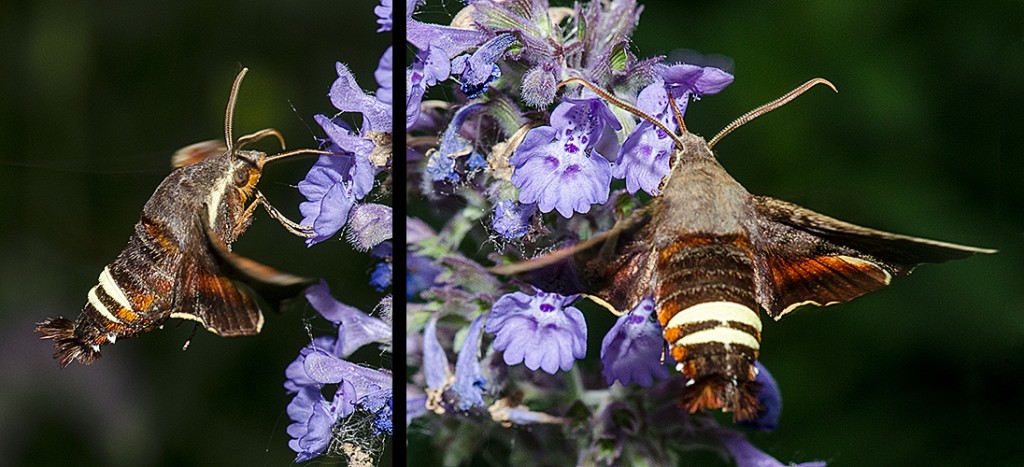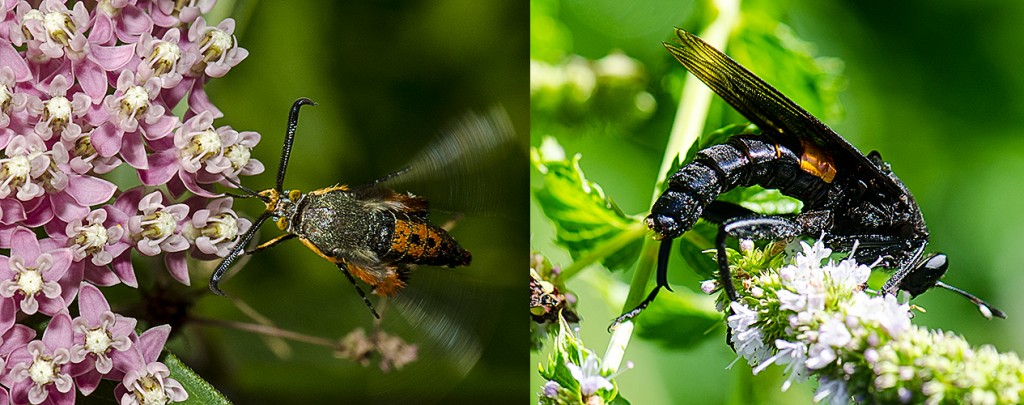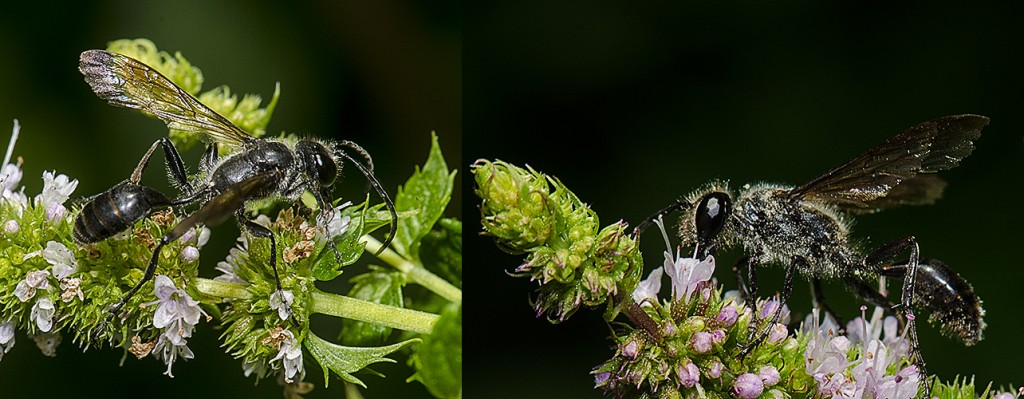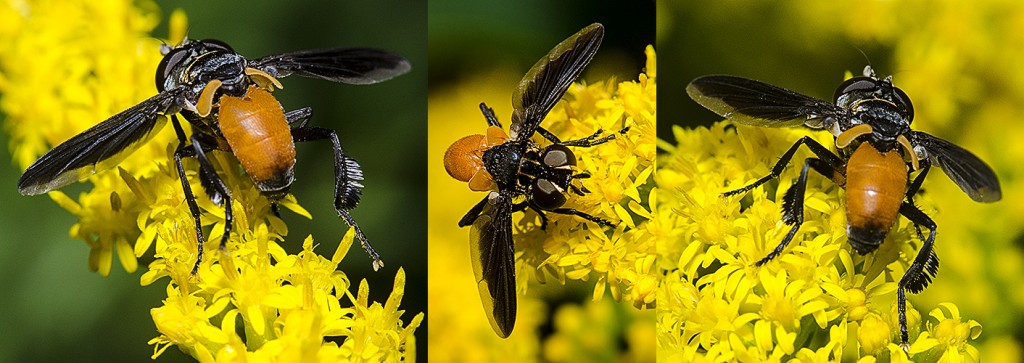Even after living twenty plus years in our house Nature continues to delight and surprise me. I often observe new insects visiting our yard in Southeastern Michigan. Sometimes they are old friends dropping by for a first visit and sometimes they are complete unknowns. Our yard is planted with insect attracting plants. Crocus (Crocus sp.) and Winter Aconite (Eranthis hyemalis) in the spring, Catmint (Nepeta sp.), Borage (Borago officinalis), Fennel (Foeniculum vulgare), Garlic Chives (Allium tuberosum), Spearmint (Mentha spicata), and Milkweed (Asclepias sp.) in the summer. Goldenrod (Solidago sp.), Asters, and Seven-son Shrub (Heptacodium miconioides) in the autumn. We use no pesticides. To make people more aware of what they can find in their own yards we have a talk titled “Insects in your (or at least our) Backyard.” Too many people kill the beneficial insects by broadly applying chemicals.
Hummingbird Moths are day flying moths that look as if they are small Hummingbirds. I often see photos or videos posted on line of “baby hummingbirds.” When Hummingbirds leave the nest they are the same size as the adults. Some species of Hummingbird Moths are reported to beat their wings at over 70 times a second. They visit flowers, feeding on nectar. These fast moving insects are a challenge to photograph.
Nessus Sphinx Moth (Amphion floridensis) visited our Catmint earlier this summer. Its body is Chocolate-brown with rusty patches. A yellow stripe above the eye and two yellow bands on the body are characteristics of this species. The end of the abdomen resembles a lobster’s tail. The insect is only an inch (2.5cm) long.
Another Hummingbird Moth to visit my yard is the Hummingbird Clearwing (Hemaris thysbe). It flies to a flower, quickly feeds, and then speeds on. In order to get its picture I had to predict (or guess) which flower it would visit and focus on that flower. Given the large number of missed shots, I’m glad I no longer use film. Its wings are see through with the edges lined in brown. The one pictured is an older, worn, moth.
Another new visitor (or just noticed visitor) is the Mydas Fly (Mydas clavatus). At first glance I thought it was a wasp but, at an inch (25mm) long, it is one of our largest flies. Their abdomens are black with an orange band. The specific name “clavatus” means club-shaped and refers to the distinctive flattened antennae segment of this species.
Often mistaken for a Bumblebee, the Eastern Carpenter Bee (Xylocopa virginica) is an important pollinator in our garden. Their smooth, shiny, abdomens distinguish them from the hairy abdomened Bumblebees. Carpenter Bees nest in tunnels that they excavate in soft wood. These tunnels are 3/8 inch (9.5mm) in diameter and eight or more inches (200+mm) deep. They look as if someone has drilled perfectly round holes into a log.
Another pollinator in our garden is the Grass-carrying Wasp (Isodontia mexicana). It is one of the thread waisted wasps, ¾ inch (19mm) long, with see-through reddish-brown wings. Its body has whitish hairs. It nests in existing cavities, sometimes using abandoned Carpenter Bee holes. The female lines the nesting cavity with blades of grass. I am always surprised to see one of these wasps flying through the air trailing a long blade of grass behind them. These species will lay several eggs in the same cavity, using plugs of grass to divide the cavity into sections, each section receiving one egg.
While watching Grass-carrying Wasps feed on Goldenrod (Solidago sp.) I observed orange abdomened flies that I had never seen before. These turned out to be Trichopoda Flies (Trichopoda pennipes). About the size of a House Fly, they have smooth, orange abdomens, solid colored in the males and black tipped in the females. Their wings are black except for a clear strip along the rear edge. They are one of the feather flies so named for the feather or comb-like structure on the hind legs.
These flies are parasitic on Stink Bugs and Squash Bugs and have been imported from the United States into Europe as a Squash Bug controller. The female fly lays her eggs on the back of a bug. The eggs hatch and the larva bore into the bug and feed upon it. When they reach maturity, they emerge from the bug and pupate in the ground. The adults hatch and the cycle begins again. I am not sure how effective this control is because the bug continues to feed and do damage to the plants long after the eggs hatch.
I never know what I’m going to see in my yard. It is fun just to grab my camera and spend a few minutes looking at what is passing through the yard. Nature surrounds us and I don’t need to travel to a distant woods or meadow to see something new.
Copyright 2015 by Donald Drife
Webpage Michigan Nature Guy
Follow MichiganNatureGuy on Facebook





